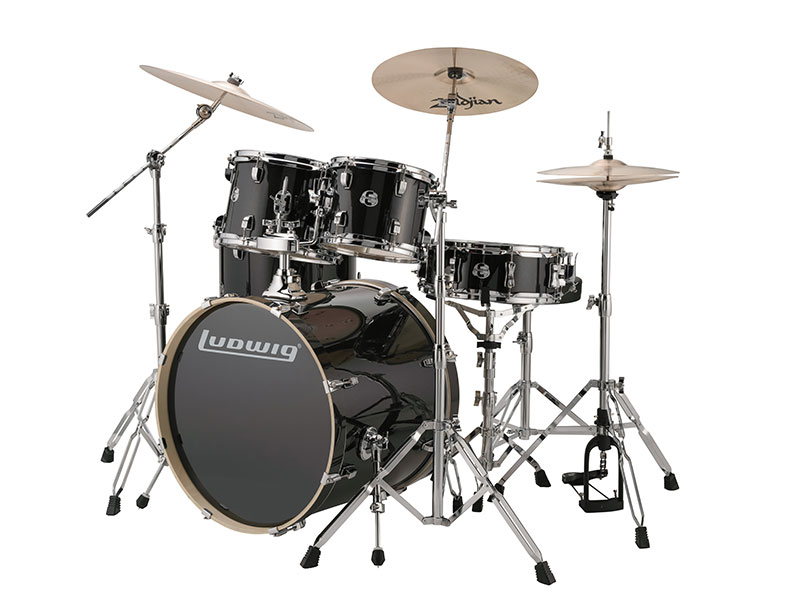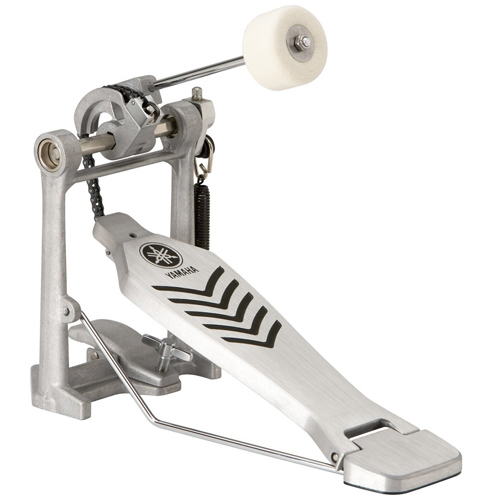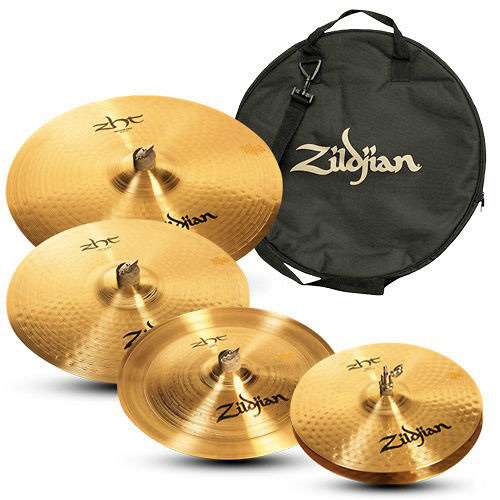So, you decided to take up the drums and it’s time to pick out your first kit. At first glance, the number of possibilities can be a little overwhelming. Should you go with a used kit or a new one? What kind of shells should you get? What kind of hardware do you need? Should you go with sheet or cast bronze cymbals? Whether you go with used or new, this guide will help you navigate the myriad of choices made in order to get you started on your path to drumming greatness.
The first thing that you need to decide is what kind of sound you are going for. Jazz? Funk? Rock? The sound that you are going for will help you determine many other factors like drums, drum heads, and cymbals.
An important factor in tonal quality of a drum is the head. A good drum head can make even an entry level drum sound great. In general, a few things to keep in mind:

The thicker the head, the darker and more focused the sound. This means less resonance and more of the fundamental pitch of the drum. If this is what you are going for, either an Emperor weight head from Remo or a G2 weight from Evans would be a good choice.
By contrast, the thinner the head, the brighter the sound created. These heads will also allow the drum more resonation. In addition, they have a lighter touch, meaning that they are great for quieter playing applications. Great examples of these heads would be the Remo Diplomat or Evans G1 families of heads.
The coating of a drumhead will also play a role in the sound produced from a drum. A coated head provides a darker, more controlled sound whereas a clear head will give you a brighter sound with more attack. A general rule of thumb is a coated head for the snare and clear heads for the toms. This is a good place to start for a beginner.
When starting out, your first question is how many drums you want and how big you want them. If jazz is your thing, you probably aren’t going to need a kit with two bass drums and seven toms. Conversely, if you plan to become a metal god, you are going to want to have more than an 18” bass drum and a couple of small toms.

Most drum sets come in packs of four or five drums, with the option of adding on other drums later. For jazz, a four-piece kit with either an 18” or 20” bass drum, 10” and 14” toms and a 14” snare would work perfectly. The most common configuration, however, is a five piece kit with a 22” bass drum, 12”, 13”, and 16” toms, and a 14” snare. This setup gives the most flexibility in terms of sound and doesn’t limit the player to one or two styles of music.
Another setup that found popularity over the last 20 years is the "fusion" kit. This type of setup includes 10”, 12”, and 14” toms, a 14” snare, and a 22” kick drum. Fusion setups are designed to give a big, deep bass with a controlled punchy tom sound, making them ideal for hip-hip, R&B, and funk. A six-piece kit provides the most flexibility, adding a 16” floor tom to the mix.

Shell material is another determining factor in the sound of a drum. While maple gives a warm, bright sound great for jazz and acoustic, birch will have a punchier, darker sound favored by recording engineers. Older drums may have been manufactured with mahogany or other hardwoods and can provide a great tone.
Maple and birch shells were only found in higher-end drumsets for many years. However, companies now make entry-level, high-quality sets with these woods at reasonable prices. When buying drums online, it’s crucial to find a demo video of the make and model of drumset you’re buying to understand the sound.
The hardware that comes with your kit is just as important as the kit itself. Making sure you have solid hardware will let you rock out (or jazz out) for years to come without worry. Oftentimes, investing in good hardware from the start is a prudent choice; you can upgrade the shells later when your musical needs call for something higher-grade.

The most important parts of the hardware are the throne and the bass pedal. These will see the most wear and tear of all your hardware. Whatever you do, invest in a comfortable throne from the outset. Your butt will thank you. Any of the thrones from Pork Pie, Roc N Soc, or the Tama First Chair series will serve you well and will last a lifetime.
A great bass pedal will also end up lasting a lifetime and can adjust to fit your constantly evolving playing style. Look for a pedal with rugged construction and options to customize. Favorites of the pros continue to be the Tama Iron Cobra, the Mapex Falcon, The DW 5000 and 9000, and the Pearl Eliminator. Each hardware and drum manufacturer has their own high-end pedal, so feel free to try out as many as possible at your local drum retailer and see what works for you.
The cymbal stands and the snare stands are the last pieces of the hardware puzzle. Most entry-level and mid-grade drum kits come with hardware included, so you may only have to or want to upgrade the throne and pedal. If durability is your goal, look for hardware with double braced legs and memory locks included in the features. If portability is your goal, single braced legs might be best when choosing your hardware. In the end, you just need to make sure that you have the right amount of hardware to hold all of your cymbals, toms, snare, gongs, and whatever else your heart desires to make your kit your own.
There is no part of a drum set more personal than the cymbals. Each drummer will end up finding a different cymbal setup that allows them to express themselves in their own way. For the drummer new to the scene, cymbals can be broken down into two different categories: sheet bronze and cast bronze. Sheet bronze cymbals are created from a sheet of metal that is rolled out and then cut out into discs that are then shaped into the final product of a cymbal. Because of the simplicity of the machining process, sheet bronze cymbals end up being far more affordable than their cast bronze counterparts, yet may lack some of the tonal complexity of their cast bronze brethren. Cast bronze cymbals start out as a single metal ingot and are then hammered out into shape, often by hand, to create the final product. They end up having a far more complex tone and are more variance, cymbal to cymbal, than your average sheet bronze product.

Sheet bronze cymbals often come in pre-packaged sets featuring hi-hats, a ride cymbal, and one or two crash cymbals. The sets give a beginner a great value for their money. The Zildjian ZBT and ZXT series, the Sabian B8 and B8 Pro series, and the Paiste PST 3, 5, 7, and 8 series all offer different setups to get a drummer started.
Once your style starts to expand, you may want to augment your sound, or change it altogether by switching over to cast cymbals. The Zildjian K and K Custom series, the Paiste Signature Series, and the Sabian HH and HHX series are all great for a darker, more atmospheric sound. The Zildjian A or A Custom, Sabian AA and AAX, and Paiste Rude Series provide a brighter sound with more attack better for loud environments. Cymbal company sites all offer sound samples to provide an idea of a cymbal’s character, but visiting your local music shop and trying a few out is never a bad idea.
Hopefully, this guide will provide you with a good amount of starting information to help you choose the perfect first drum set. In the end, the choice is yours and yours alone, and it really just comes down to you sitting down and finding the kit that feels right. Your first drum set will certainly not be your last, but it should be one that lasts and is able to provide that sound and durability that will match your own musical personality. Now get out to your nearest drum shop and start test driving some drums.
